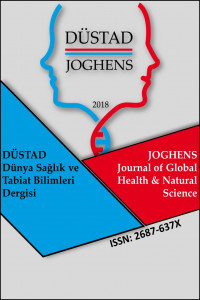Evaluation of NSE and GFAP level and hemorrhage volume in terms of prognosis in head trauma:A prospective controlled study.
Head trauma, intracranial, hemorrage volume
___
- 1) Taylor CA, Bell JM, Breiding MJ, et al. Traumatic Brain İnjury-Related Emergency Depart-ment visits, hospitalizations, and deaths-United states 2007 and 2013. Center for disease con-trol and prevention. Morbidity and mortality weekly report. Surveillance summaries/Vol. 66/No.9, March 2017
- 2) Thelin E, Nimer FA, Frostell A, Zettenberg H, Blennow et al. A serum protein biomarker panel ımproves outcome prediction in human traumatic brain injury. Journal of Neurotrauma 36:2850-2862 (October 5,2019). DOI:10.1089/neu.2019.6375
- 3) Teasdale G, Maas A, Lecky F, et al. The Glasgow Coma Scale at 40 years: standing the test of time. Lancet Neurol 2014; 13: 844–54
- 4) Fanygersh V, Passero M. Estimating Radiation Risk from Computed Tomography Scanning. Lung (2009) 187:143–148. DOI 10.1007/s00408-009-9143-9
- 5) Bazarina J, Biberthaler P, Welch RD et. al. Serum GFAP and UCH-L1 for prediction of ab-sence of intracranial injuries on head CT (ALERT-TBI): a multicentre observational study. www.thelancet.com/neurology Published online July 24, 2018 http://dx.doi.org/10.1016/S1474-4422(18)30231-X
- 6) Zetterberg H,Smith DH, Blennow KH. Biomarkers of mild traumatic brain injury in cerebro-spinal fluid and blood Nat Rev Neurol. 2013 April;9(4):201-210. Doi:10.1038/nneurol.2013.9.
- 7) Papa L, Robinson G,Oli M et al. Use of biomarkers for diagnosis and management of trau-matic brain injury patients. Expert Opin. Med. Diagn. (2008) 2(8):937-945
- 8) Mehta T, Fayyaz M, Giler GE et al. Current Trends in Biomarkers for Traumatic Brain Injury. Open Access J Neurol Neurosurg. 2020;12(4):86-94.
- 9) Vos PE, Lamer KJB, Hendricks JCM et al. Glial and neuronal proteins in serum predict out-come after severe traumatic brain injury. NEUROLOGY 2004;62:1303–1310
- 10) Nylen K, Öst M, Csajbok LZ et al. Increased serum-GFAP in patients with severe traumatic brain injury is related to outcome. Journal of the Neurological Sciences 240 (2006) 85 – 91
- 11) Bazarina J, Biberthaler P, Welch RD et. al. Serum GFAP and UCH-L1 for prediction of ab-sence of intracranial injuries on head CT (ALERT-TBI): a multicentre observational study. www.thelancet.com/neurology Published online July 24, 2018 http://dx.doi.org/10.1016/S1474-4422(18)30231-X
- 12) Aydın I, Algın A, Poyraz MK et al. Diagnostic value of Glial fibrillary asidic protein and S100B serum levels in emergeny medicine patients with traumatic versus non traumatic hem-orrhage. Nigerian journal of clinical practice.2018; Vol:21(12).p:1645-1650
- 13) Duda İ, Wiorek , Krzych LJ. Biomarkers Facilitate the Assessment of Prognosis in Critically Ill Patients with Primary Brain Injury: A Cohort Study. Int. J. Environ. Res. Public Health 2020, 17, 4458; doi:10.3390/ijerph17124458
- 14) Mrozek S, Dumurgier J,Citerio G et al. Biomarkers and acute brain injuries: interest and lim-its. Critical Care 2014, 18:220.p:2-12. http://ccforum.com/content/18/2/220
- 15) Tito A, Saragih SGR, Natalia D. Comparison of Revised Trauma Score Based on Intracranial Haemorrhage Volume among Head Injury Patients. Prague Medical Report / Vol. 119 (2018) No. 1, p. 52–60
- 16) Salihovic D, Smajlovic D, Ibrahimagic OC. Does the Volume and Localization of Intracere-bral Hematoma Affect Short-Term Prognosis of Patients with Intracerebral Hemorrhage? Neuroscience Volume 2013, Article ID 327968, 3 pages. http://dx.doi.org/10.1155/2013/327968
- 17) Castellanos M, Leira R, Tejada J et al. Predictors of good outcome in medium to large sponta-neous supratentorial intracerebral haemorrhages. J Neurol Neurosurg Psychiatry 2005;76:691–695. doi: 10.1136/jnnp.2004.044347
- 18) Diren F, Civelek E, Kabataş S. Brain immunology and neuroinflammation in head trauma. Türk Nöroşir Derg . 30(2):209-216,2020
- 19) Pelinka LE,Kroepfl A, Schmidhammer R et al. Glial Fibrillary Acidic Protein in Serum After Traumatic Brain Injury and Multiple Trauma. J Trauma. 2004;57:1006 –1012.
- 20) Duchen, LW. General pathology of neurons and neuroglia. In: Adams, JA.; Corsellis, JAN.;Duchen, LW., editors. Greenfield’s Neuropathology. London: Edward Arnold; 1984. p. 1-52.
- 21) Sharguie IK, Gawwam GA, Abdullah SF. Serum glial fibrillary acidic protein :A surrogate marker of the activity of multiple sclerosis. Medeni Med J. 2020;35:212-8
- 22) Vos PE, Jacobs B, Andrissen TMJC et al. GFAP and S100B are biomarkers of traumatic brain injury. An observational cohort study. Neurology 2010;75:1786–1793
- 23) Meriç E, Gündüz A, Turedi S et al. The prognostic value of neuron-specific enolase ın head trauma patıents. The Journal of Emergency Medicine, Vol. 38, No. 3, pp. 297–301, 2010
- 24) Cheng F, Yuan Q, Yang J et al. The Prognostic Value of Serum Neuron-Specific Enolase in Traumatic Brain Injury: Systematic Review and Meta-Analysis. Plos One.2014: Vol.9(9). e106680
- 25) Miao Q, Cai B, Gao X et al. The establishment of neuronspecific enolase reference interval for the healthy population in southwest China . Scientific Reports | (2020) 10:6332 | https://doi.org/10.1038/s41598-020-63331-x
- ISSN: 2687-637X
- Yayın Aralığı: Yılda 2 Sayı
- Yayıncı: Durmuş Ali ARSLAN
Perisuyu Çayı Üzerindeki Hidroelektrik Santraller ve Etkilenmesi Muhtemel Balık Türleri
Mücahit EROĞLU, Mustafa DÜŞÜKCAN, Mehmet Zülfü ÇOBAN
Elif ÇELİKEL, Ahmet Burak ERDEM, Selçuk PARLAK, Çiğdem YÜCEL, Esra ÇIVGIN, Turan TURHAN, Cemil KAVALCI, Evvah KARAKILIÇ, Berkin KARAPINARLI
Abdullah Emre SAFİ, Serpil MİŞE YONAR
Abdullah Emre SAFİ, Serpil MİŞE YONAR
Evsel Atıklar Kullanılarak Laboratuvarda Alg Üretim Yöntemleri
Tahir ATICI, Bilge Başak FİDAN
Türkiye’deki Kadınların Meme Kanseri Tarama Yöntemlerine Yönelik Farkındalıklarının İncelenmesi
Büşra CEYHAN, Kadir ATAKIR, Gülçin ÖZEVCİ
Safa DÖNMEZ, Ahmet Burak ERDEM, Alp ŞENER, Abdullah Osman KOCAK
Bilal İLANBEY, Süleyman ERSOY, Alp YILDIRIM
Farklı Tuz Konsantrasyonu ile Tuzlanmış Alabalık Üretim Analizi
